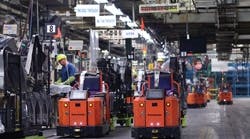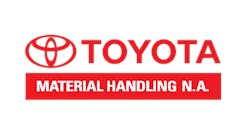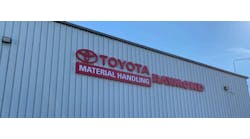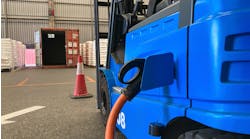While survivors of the most recent recession have learned to do more with less, vendors of material handling equipment and systems have had to learn survival skills of their own. That process is having a dramatic impact on their customers’ operations. Both OEMs and dealers are working with equipment users to craft solutions rather than pitch products.
For some users that may mean lift truck automation; for others it may mean facility consolidation. For everyone it means willingness to adopt a new way of thinking. That’s what characterizes today’s lift truck market.
From Lift Truck to AGV
Even Toyota Motor Corp. (www.toyota.com), masters of Kaizen, or “continuous improvement,” continues to find new forms of waste in its most efficient operations. That was the case at Toyota Motor Manufacturing, Kentucky (TMMK) (www.toyotageorgetown.com), the company’s largest manufacturing facility outside of Japan. It is also one of its older plants, dating back to 1986.
Here, more than 6,600 employees are dedicated to producing the Avalon, Camry, the Camry Hybrid and the Venza, as well as four- and six-cylinder engines, and power train parts. This Georgetown, Ky., plant has the capacity to build 500,000 vehicles and engines annually.
Waste was found in the use of some of this facility’s 7.5 million sq ft of space. Because of the building’s size, material doesn’t flow as well from one process to the next as it does in the company’s newer factories. Parts delivery trains travel congested areas and tight corners.
To deliver parts from stamping operations to robotic welding cells, the TMMK Body Weld department worked with TMHU (www.toyotaforklift.com) and AutoGuide (www.autoguideagvs.com) to retrofit Toyota tow tractors with AGV kits, giving them the capability to be both manned and unmanned. The 24-volt, AC-drive units feature a 10,000-lb. payload capacity.
AutoGuide equipped the 10,000 lb.-capacity tow tractors with obstacle sensors, guidance sensors, radio frequency modems, Radio Frequency Identification (RFID) tag readers and other technology. It used the same off-the-shelf sensors and devices installed on other AGVs in the TMMK plant. These units share the same magnetic guide pathway.
System Integration firm Industrial Concepts Incorporated (ICI) (www.ici-ky.com) worked with the TMMK AGV implementation team to develop the AVINU traffic control system (Automated Vehicle Intersection Navigational Utility). It monitors the activity of each AGV as it travels “Spaghetti junction,” consisting of a 300-foot main highway with nine different routes branching off and merging into it. Besides reporting vehicle location and performance, the control system also shows battery charge, assigns available AGVs to loads and regulates traffic at vehicle intersections.
As a result of this new flow, fewer parts are damaged in transit to the body weld portion of the TMMK plant. Cycle time was reduced by 35 seconds, saving 317 labor hours per year. There was also a dramatic reduction in floor-space requirements, as well as better process discipline among employees.
Paul Stafford, production engineering specialist and AGV implementation lead at TMMK, says the relationship forged between his company’s executive team, TMHU, AutoGuide and the system integrators at ICI was a leap of faith for everybody, but it’s also indicative of a business perspective industries need to adopt.
“The Toyota philosophy is if you’re not failing, you’re not trying,” he said. “You have to learn from failures, adapt, overcome, change and take the next step.”
Narrow-Space Age
While automated lift trucks can help manufacturers improve production flows to meet the demands of internal customers on the line, many companies are also reconsidering how they flow products through distribution to better meet the varying service demands of diverse customers throughout their supply chain. That underlines the need to consider lift trucks in a system context.
For Zanders Sporting Goods (www.gzanders.com), located in Sparta, Ill., this mindset has played a key role in helping the company protect its relationship with customers and dealers during market turbulence. In fact it enables this company to offer many service options such as same-day shipping and rapid special orders.
Zanders consolidated a number of its facilities into one 72,000-square-foot location in 2010. This drastically changed the handling environment in which employees worked, including the implementation of narrow aisles and automated carousels (www.kardexremstar.com/us). The goal was to ship orders out faster, protect from any product damage in its narrow-aisle environment and decrease the number of times products are handled.
According to Stefanie Zanders-Key, general manager for Zanders, going to a narrow-aisle environment enabled them to add more products and provide fulfillment services it couldn’t have handled in its previous setting.
“We couldn’t get the product out, so we couldn’t take in more business,” she adds. “We handle guns, ammunition, accessories, anything having to do with hunting and shooting. Because we sell to many different retail stores, some very small and some large, we might sell one box of ammunition to the small store where the next one might buy a pallet or 10 cases. We have to be able to stock all these different quantities.”
From a lift truck perspective, that required the ability to handle their heaviest loads—a job for which Zanders previously used propane-powered lift trucks. But in the transition to a new warehousing environment making use of narrow aisles and more confined spaces, electric seemed like a better option from a clean air perspective.
Working with Heubel Material Handling (www.heubel.com), their Raymond (www.raymondcorp.com) lift truck dealer, Zanders replaced most of their propane trucks with pre-owned Raymond ReNewed electric lift trucks, including orderpickers and swing-reach trucks. This new assortment of lift trucks enabled Zanders to store and pull product from its very narrow aisles more efficiently—with the help of wire guidance.
Products that are brought into the warehouse are picked up by lift truck and guided by an operator to the appropriate aisle. The wire guidance system allows operators to steadily transfer those products down these narrow aisles by electronically engaging a guide wire on the warehouse floor. This helps decrease the possibility of collisions or product damage. The system also enables operators to travel at higher speeds in narrow aisles. As a result, damage has been reduced by 75%.
“With an employee on an order picker, the machine takes him up to do the picking, so they no longer have to climb ladders and they’re no longer trying to carry product down the ladder to put it on a cart,” says Zanders-Key. “It’s safer and they can now pick four to eight orders at a time as opposed to one.”
Zanders now operates on a 12 hour shift. Zanders-Key says there was more overtime worked in the old facility—done by more people trying to get out less product. Sixteen to 20 people picked to carts. Since the transition three people on order pickers work the racking while one person picks from the carousels. During peak time those numbers can go up to four in the rack and two on the carousels.
Zanders will eventually add another pod of four carousels. And with online business growing the company will provide fulfillment services for some of its larger customers so they no longer have to handle products.
Zanders’ consolidated operations have paid off several ways. With the carousel replacing the labor of eight to 10 pickers of smaller items, savings range between $280,000 to $350,000 per year. Zanders-Key estimates that will pay for the system in less than two years.
Adopting narrow-aisle storage with wire guided order pickers has made the operations safer, cutting the number of workers compensation claims in half.
Consultative Approach
By taking a systems approach to lift truck selection and working with a material handling equipment service provider to do an operations analysis, fleet managers and their operators are likely to identify many opportunities to improve overall facility efficiency.



